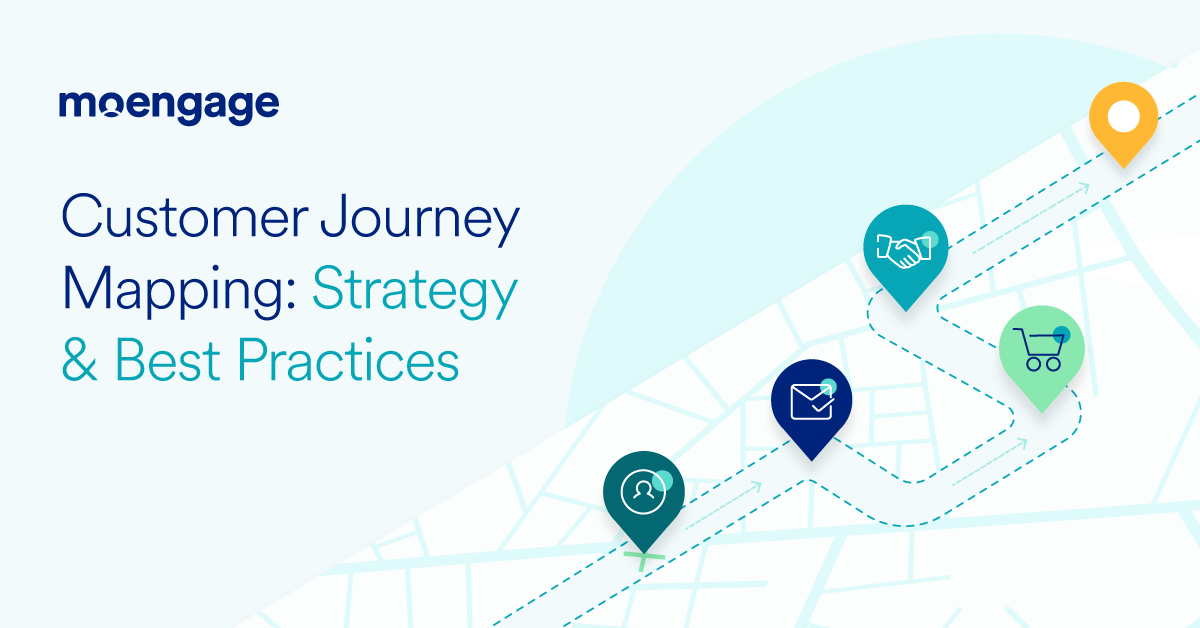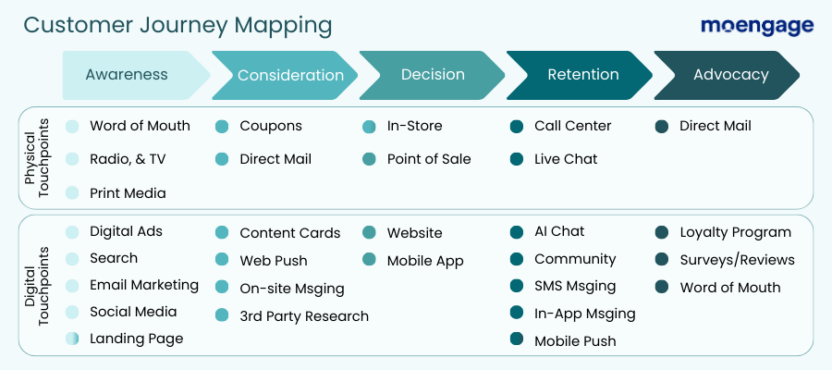Customer Journey Mapping: Strategy & Best Practices

Reading Time: 11 minutes
In the face of modern hyper-connectivity, meeting and exceeding customer expectations is more challenging than ever. Businesses strive to curate connected and high-value experiences across all customer touchpoints, but that requires the ability to visualize the customer journey to understand customer intention and sentiment.
The traditional way of customers visiting a store, browsing for products, and making a purchase has changed. Nowadays, purchasing decisions are influenced by marketing messages across various channels.
Even after a customer makes a purchase, they are engaged post-purchase through channels like email, mobile push, and SMS in an effort to drive retention and repeat purchases. In some cases, they’re incentivized to download an app, sign up, and join loyalty programs that foster brand loyalty.
As you can imagine, these omnichannel customer journeys can become extremely dynamic and complex, with a variety of entry and exit points. To make sure you meet customer needs and keep your visitors interested, you need to take a customer-centric approach to innovation.
Here, we’re taking a detailed look at different ways to use a customer journey map to craft omnichannel journeys that customers love. The different tactics, types, and templates we explore will illustrate how brands can use a customer journey map to their best advantage.
What Is Customer Journey Mapping?
Customer journey mapping is the process of creating a visual representation of every interaction a customer has with a brand via a particular pathway. The resulting customer journey map helps marketers understand the actions that customers take and how those actions are influenced positively or negatively by any marketing strategy or experience.
To accurately map out customer pathways, brands commonly break the customer journey down into 5 main phases that reflect the stage of customer engagement they are at.

When used properly, customer journey mapping helps brands understand how their customers interact with them. This allows them to increase exposure, acquire new customers, motivate a purchase, ensure retention, and develop brand loyalty and advocacy.
10 Reasons Why Customer Journey Mapping Is Important
Customer journey mapping is an intensive and data-heavy exercise. It requires a deep dive into customer data to understand how customers interact with your business. It forces brands to examine the customers’ needs and expectations that are driving their interactions.
This focus on the customer and understanding them fundamentally offers many benefits to the modern marketer. The following are just a few examples of how customer journey mapping can positively influence a business and empower it to maximize customer engagement.
1. Match customer expectations with reality
Although brands aspire to be more customer-centric, this is easier said than done. There is often a disparity between customer expectations and business deliverables.
Customer journey mapping allows brands to step inside the customers’ shoes and experience the customer journey first-hand. Doing so helps them to identify bottlenecks and drop-off points that cause the expectation-reality gap, and addressing these barriers can cater to unmet needs.
2. Identify new opportunities for improvement
A customer journey map illuminates customer pain points that would have otherwise gone unnoticed or unrealized. These specific customer pain points lend deeper insight than general market or trend research. Pain points are no longer a sore spot: they are an opportunity to improve or branch into a new product/service segment.
For instance, subscription-based companies may observe on customer journey maps that long-term and costly plans discourage prospects from converting into paying customers.
To offset this, they introduce smaller plans that are more cost-effective and tap into a wider clientele. For example, Spotify’s one-day Premium Mini pack — letting listeners test out their service for one day or one week — makes the most of that pain point and flips it into a distinct opportunity.
3. Distill complex journeys
Traditional customer journeys were fairly straightforward. Your sales and marketing team would carry out cold outreach (typically through a limited number of channels), nurture the prospect, and push for a sale. In contrast, modern-day customer journeys have grown increasingly complex due to a buffet of offline and online touchpoints.
To complicate things further, nearly 3/4th of consumers prefer shopping through multiple channels. As such, an omnichannel marketing strategy is a must for businesses looking to stay sustainable and profitable. Keeping tabs on omnichannel customer journeys can be difficult.
Customer journey mapping can eliminate guesswork and grant visibility to even the most complex customer journeys. It can also help you prioritize and optimize customer journeys by focusing on the right set of channels for your brand.
4. Reveal different buyer personas
In addition to charting complex customer journeys, a customer journey map can also help with segmenting the different target customer personas into smaller buyer persona cohorts.
For instance, younger, tech-savvy prospects may blaze through the customer journey, while the older generation may require some assistance — sometimes with the help of human agents.
The customer journey map for one cohort will look materially different, with different touchpoints, because of this. Different buyer personas may have different requirements that shape their journey.
Matching personas with shared traits to their respective customer journeys will ensure greater relevance.
5. Enable emotionally-driven marketing
Emotional marketing and branding are not new, but the modern market demands them in a whole new way. Constant feedback channels that capture customer impact and sentiment open up a new world for marketers. Customer journey maps highlight this emotional component and make it easy for businesses to empathize in real time.
For example, the customer journey map may highlight customer frustrations when they have to connect with support over the telephone and email. Introducing a chatbot at this stage could improve the speed of customer inquiries being addressed and improve customer sentiment.
6. Provide an opportunity for personalization
On average, personalization can increase revenue by 10 to 15%. While businesses recognize the importance of personalization, they may lack the strategies or resources to extend it to their customers. Customer journey maps are one of the easiest tools for understanding customer intent across all touchpoints, and they can even lay the groundwork for hyper-personalization.
7. Boost collaborative teamwork
Customer journey mapping involves a variety of cross-functional stakeholders — like sales, marketing, product development, customer service team, etc. — working together to achieve a common goal.
Working together to create a living document offers a high-level view of every team’s roles, responsibilities, and contributions to the brand’s collective success.
Team members can grow to understand and appreciate what others do in a way that fosters future creativity. As team members gain perspective on how functions affect the performance of other related teams, they can act on new insight. All of this promotes collaborative action and builds brand cohesion.
8. Make customer interactions more meaningful
Whether you survey customers after cart abandonment or engage them through the onboarding process, every customer interaction should have something of value at its core. The problem is that businesses often lack the foresight or data to anticipate what is valuable to the customer at specific touchpoints.
For instance, offering free shipping when a customer is at the checkout page could incentivize certain customers to complete a purchase, but if the customer has a problem relating to shipping, it could change the way that they interact with that offer. The value customers seek is highly subjective. Customer journey mapping helps to identify these subjectivities and make providing value to your customers more accessible.
9. Improve the customer experience
The concept of customer journey mapping sounds similar to a buyer’s journey (or a user’s journey), and they are, in a way. They mark how a customer progresses from a lead to a prospect, then to a one-time buyer, and finally, either to a lapsed customer or a brand evangelist.
A key difference between the two is that a customer journey map tells the story from the customer’s perspective, rather than the lens of the brand. In this manner, brands can get first-hand insights by stepping into the customer’s shoes.
In doing so, brands ensure their customers are heard and that their needs are clear. These first-hand insights from the customer inevitably lead to better, customer-informed experiences. An example we used above is the implementation of chatbots to improve customer support.
This action is a solution derived directly from a customer-stated problem. This earnest, goal-oriented approach builds stronger rapport with customers.
10. Create upsell and cross-selling opportunities
Effective journey mapping reduces friction for customers, making it easier for them to buy products they love. When done right, customer journey mapping factors where the best places are to deploy upsell and cross-sell opportunities.
Integrate upsell and cross-sell opportunities into your campaign at the optimal points and via the ideal channel to drastically increase engagement with your campaigns.
By offering customers personalized recommendations based on their previous activity, what they are currently shopping for, and similar customer behavior, you ensure customers get relevant recommendations that make their shopping experience easier and more convenient.
Over time, this empowers you to increase average order value (AOV) and customer lifetime value (CLV).
Types of Customer Journey Maps and When To Use Them
Customer journey maps are going to vary elementally based on the customer personas being explored and the goals of any individual brand. This table outlines common types of customer journey maps and how they can be best utilized for your team for maximum gains.
| Type of Customer Journey Map | Purpose of the Customer Journey Map | Best Used For |
| Customer Experience Maps | To visualize the customer behavior, activities, interactions, and emotions before any outcome — purchase, drop-off, advocacy, etc. — from the customer’s perspective. | Understanding customer expectations, needs, and wants, and how they align with the brand’s products or services. |
| Current State Maps | To introduce improvements to the existing customer journey map by observing bottlenecks and opportunities, and how various innovations can affect it. | Monitoring, analyzing, and improving the existing customer journey map and identifying any gaps and deficiencies (commonly used in conjunction with Future State Maps). |
| Future State Maps | To document the ideal customer journey map and understand the impact of introducing any changes to the customer journey. | Benchmarking of what your customer journey map should ideally look like. |
| Empathy Maps | To recognize the different emotions that go into the decision-making process. | Capturing customer sentiments and emotion-centric feedback to enhance customer journeys. |
| Day in the Life Maps | To gain an understanding of customer behaviors and routines (typically used in the software and SaaS domain). | Building customer experiences that are harmonious with the customer’s usage. |
| Persona-Based Customer Journey Maps | To understand how different customer personas interact with your brand and further focus the scope of specific journey maps. | Personalizing the customer experience in relation to the buyer persona. |
| B2C | To develop a reactive understanding of a much shorter sales cycle. Though less complex than B2B, the sophistication of mobile interactions requires an emotive focus and a delicate touch. | Marrying a drive toward quick conversions while also focusing on retention and growth. Widely variable decision and consideration stages dependent on the type of service or product. |
| B2B | To manage the additional complex touchpoints relating to negotiation and deeper layers of research, as well as the larger number of customer personas to inform on multiple stakeholders who contribute to decision making. | Factoring in the cyclical nature of the B2B stakeholder journeys. To determine how best to engage variable decision makers with different priorities. To manage a customer journey that is often much longer and more drawn out than others. |
| Omnichannel | To map out interaction across all online and offline touchpoints to determine the brand’s success or need for improvement on seamless interconnectivity. | Observing variable pathways to conversion. Strengthening weak touchpoints and augmenting less productive customer channels. |
| Ecommerce | To observe the sophisticated mobile interactions of customers in the digital space. | Emphasizing areas of improvement for accessibility and the user interface to resolve technological pain points for customers. |
| Retail | To analyze how customers are interacting with the products available and the overall brand associations they are making. | Balancing the efficacy of digital and brick and mortar channels and bridging gaps in tangible service support. |
6 Best Practices for Creating an Actionable Customer Journey Map
If you are looking for comprehensive instructions, We have written a guide on How to Create a Customer Journey Map in just 10 steps. In addition, we have compiled more recommendations to help marketers make the most of their mapping strategy.
1. Start small, then scale up
In an ideal world, businesses could make a perfectly refined customer journey map from the get-go. However, the process of customer journey mapping is iterative and regularly revisionist. Rethink, redo, and review.
Customer journey maps should be revisited and revised every 6 to 12 months — so there is no pressure — and no best possible version other than the one you are actively using to improve the experiences of your customers.
Start with low-fidelity customer journey maps and build on them with time and accumulating data. Gain instant value and use it to make every subsequent version even more effective.
2. Create a customer journey map based on research and feedback
Customer feedback, market research, and service/product usage analytics are some of the best data sources for creating a customer journey map.
They accurately reflect the theoretical and practical aspects of the average customer experience. This data allows brands to meet customers’ current expectations, introduce innovations with the intent to exceed those established expectations and execute historically-backed new products and services in ways that will delight customers in unexpected ways.
3. Look beyond your sales and marketing funnel
While the marketing funnel can be an excellent starting point for creating a customer journey map, that’s not all there is to it.
Your customer journey map stages should expand beyond the traditional marketing funnel to promote customer loyalty. You should also factor in post-purchase customer service to strive toward the goal of active customer advocacy.
4. Build your journey maps around clear objectives
Businesses need to develop a system to prioritize the channels and types of customer journey maps that are specifically relevant to them.
The modern web of customer interaction is interwoven in perpetuity. If a brand doesn’t focus on the scope of its goals, it could get stuck in the drafting phase and never find its way out. Any touchpoint can be the beginning of a customer journey map — it’s up to your team to determine what points are relevant and actionably significant.
5. Identify the right metrics and KPIs
Depending on the purpose of your chosen customer journey map, it may include different sales and marketing stages or the feelings, thoughts, emotions, and actions of the customer being analyzed.
Some maps may be more granular, while others used more as a skeletal framework to be built upon.
A great customer journey map will be measured by the right metrics and KPIs to suit your brand. For instance, you may choose to measure metrics like NPS (Net Promoter Score) or CSAT (Customer Satisfaction Score) to understand customer sentiment. It’s crucial that you’re able to record achievement benchmarks and measure progress accurately.
6. Build content for different customer journey map stages
The intent of the customer journey map is to create actionable opportunities. Brand-generated content and copy should be inspired and developed cohesively through the revelations provided by your map.
Seize opportunities for better personalization, reward customers with relevant interactions, and allow these tools to complement and elevate one another.
5 Customer Journey Mapping Templates to Get You Started
The visualization aspects of customer journey mapping can often make the early drafting stages hard for teams to wrap their minds around.
To help make that process more accessible, we recommend the following applications and associated templates to get you started depending on where you want to begin:
- Miro: They have a base template that is easy to use and effective for beginners who are in the early stages of figuring out how customer journey mapping can elevate their marketing strategies.
- Custellence: They offer more elaborate and varied templates for multiple types of journey maps. It offers a lot of leading information and examples to help determine which maps best suit your business goals and scope.
- Canva: They deliver clear, step-by-step delineation between Buyer’s Journey and Customer Journey Mapping, as well as a breakdown of the possible components offered in their templates. They offer many of the template types we have described above.
- Envato: They are a visual components provider that offers a wide array of graphic templates. These offerings can be more effective when you are factoring in the presentation components of your customer journey map. They offer a wide array of visual designs that can give your customer journey map a bit more oomph.
- Figma: They uniquely prioritize a template for an empathy map if that particular template is significant to your brand.
Customer Journey Mapping Strategy: Concluding Thoughts
A customer journey map is a living document that helps teams visualize growth stemming from customer interactions and experiences and orchestrate seamless customer journeys.
Implementing journey maps can engage customers, enhance their experience, and ensure you are meeting their expectations and addressing their pain points. These material contributions increase revenue potential, streamline business processes, and humanize the brand, building momentum toward the ultimate goal of customer engagement and brand advocacy from your audience.
Schedule a demo to see how we help brands face journey challenges head-on with Flows and other tools designed to create connected customer experiences.















